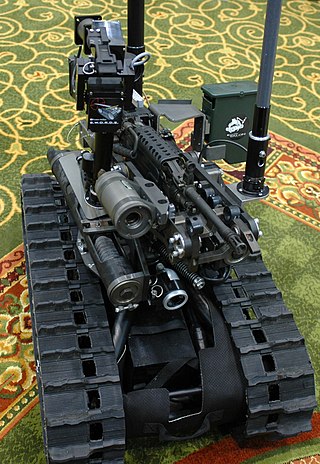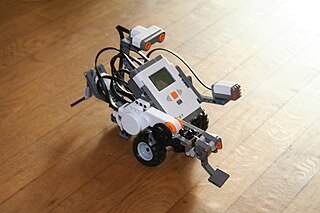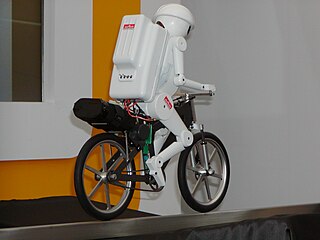
Lego Mindstorms was a discontinued hardware and software structure which develops programmable robots based on Lego building blocks. Each version includes computer Lego bricks, a set of modular sensors and motors, and parts from the Lego Technic line to create the mechanical systems. The system is controlled by the Lego bricks which act as the brain of the mechanical system.

Roomba is a series of autonomous robotic vacuum cleaners made by the company iRobot. Introduced in September 2002, they have a set of sensors that enable them to navigate the floor area of a home. These sensors can detect the presence of obstacles, particularly dirty spots on the floor, and steep drops.

iRobot Corporation is an American technology company that designs and builds consumer robots. It was founded in 1990 by three members of MIT's Artificial Intelligence Lab, who designed robots for space exploration and military defense. The company's products include a range of autonomous home vacuum cleaners (Roomba), floor moppers (Braava), and other autonomous cleaning devices.
Motion detection is the process of detecting a change in the position of an object relative to its surroundings or a change in the surroundings relative to an object. It can be achieved by either mechanical or electronic methods. When it is done by natural organisms, it is called motion perception.

i-Cybie (爱赛比) is a robotic pet that resembles a dog. It was manufactured by Silverlit Toys Manufactory Ltd Hong Kong from 2000 to 2006. i-Cybie was developed for commercial distribution by Tiger Electronics. Outrageous International Hong Kong distributed the electronic pet from 2005 to 2006. The i-Cybie robotic dog responds to sound, touch, movement, and voice commands. The toy robot can autonomously recharge its batteries using a special docking station. I-Cybie was the first mass-produced toy that used advanced voice recognition technology.

Wakamaru is a Japanese robot made by Mitsubishi Heavy Industries that is intended to perform natural communication with human beings. The yellow, 3-foot domestic robot debuted in 2005 at a $14,300-$15,000 USD price-point exclusively for Japanese households. Through its development, the Wakamaru has been used for presenting at exhibitions, guiding customers, and working as a desk receptionist. However, the Wakamaru has not advanced beyond its first model that was released in 2005.

The Foster-Miller TALON is a remotely operated vehicle, and it is a small, tracked military robot designed for missions ranging from reconnaissance to combat. It is made by the American robotics company QinetiQ-NA, a subsidiary of QinetiQ.
Parallax Inc. is a privately held company in Rocklin, California. Parallax Inc. designs, manufactures, and sells BASIC Stamp microcontrollers, Propeller microcontrollers, microcontroller accessories, educational robot kits, and educational curriculum.
The Roboreptile is a toy robot by WowWee. The Roboreptile has infrared and sound sensors, and is able to autonomously explore its environment while avoiding obstacles. It can also operate in different modes where it simulates behaviors of real animals. It is able to rear up on its hind legs and attack. Roboreptile was released in China on the 28 April 2006 and to the rest of the world later that year. It is superficially similar to a theropod or a prosauropod dinosaur but being quadrupedal it's better equated to a silesaurid or a monitor lizard.

Lego Mindstorms NXT is a programmable robotics kit released by Lego on August 2, 2006. It replaced the first-generation Lego Mindstorms kit, which was called the Robotics Invention System. The base kit ships in two versions: the Retail Version and the Education Base Set. It comes with the NXT-G programming software, or optionally LabVIEW for Lego Mindstorms. A variety of unofficial languages exist, such as NXC, NBC, leJOS NXJ, and RobotC. The second generation of the set, the Lego Mindstorms NXT 2.0, was released on August 1, 2009, featuring a color sensor and other upgraded capabilities. The third generation, the EV3, was released in September 2013.

Push the Talking Trash Can was a radio-controlled robot which made daily rounds throughout Tomorrowland at Disneyland and Disney California Adventure Park, Hong Kong Disneyland park, Disneyland Paris, Tokyo Disneyland in Japan and formerly the Magic Kingdom at Walt Disney World.

Teledyne FLIR LLC, formerly FLIR Systems Inc,, a subsidiary of Teledyne Technologies, specializes in the design and production of thermal imaging cameras and sensors. Its main customers are governments and in 2020, approximately 31% of its revenues were from the federal government of the United States and its agencies.
The Battlefield Extraction-Assist Robot (BEAR) is a remotely controlled robot developed by Vecna Robotics for use in the extraction of wounded soldiers from the battlefield with no risk to human life. The humanoid robot uses a powerful hydraulics system to carry humans and other heavy objects over long distances and rough terrain, such as stairs.
Referred to as "The first true robotic arthropod," Roboquad is one of the 5 robots that WowWee announced at CES in January 2007. It is a 4-legged robot that somewhat resembles a spider and a dog. Also designed by Mark Tilden, the Roboquad, like other WowWee robots, has multiple personalities, awareness of its surroundings, some autonomous behaviour and can be controlled via a remote.

HEXBUG is a brand of infrared and automaton toys developed and distributed by Innovation First International. HEXBUG uses many elements used in BEAM robotics. First piloted in the US through RadioShack, HEXBUG is now sold in most major retail stores. The original Hexbugs are based on six-legged arthropods but now come in several different varieties. The name "HEXBUG" relates to the six-sided packaging it is sold in, rather than to its number of legs.
Genibo is a robotic dog produced by the Korean company Dasarobot of Dasatech.
Dexter Industries is a company that designs robots for education, research, and personal use. The company makes several products that expand the LEGO Mindstorms, Raspberry Pi and Arduino prototype system.

Counter-IED equipment are created primarily for military and law enforcement. They are used for standoff detection of explosives and explosive precursor components and defeating the Improvised Explosive Devices (IEDs) devices themselves as part of a broader counter-terrorism, counter-insurgency, or law enforcement effort.

Murata Boy and Murata Girl are two self-balancing robots developed by Murata Manufacturing, a Japanese electronic components company. The company developed the robots to showcase a range of their products and generate publicity. The robots are designed to be as energy-efficient as possible, both in their basic technological components and through features like automatic sleep mode.
The Sony Xperia XA Ultra is an Android smartphone manufactured by Sony Mobile Communications. It was announced in May 2016 and was released in July 2016.












